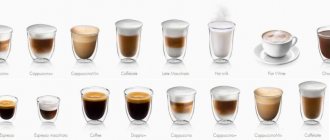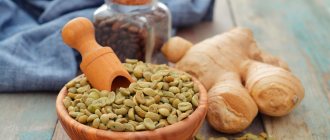Learning how to make the right, delicious cappuccino is relatively easy, but it will likely take some practice before you get the perfect combination of slightly bitter espresso and thick, creamy crema. The easiest way to prepare this drink is in a coffee machine with the ability to froth milk. Of course, the nuances depend on the device itself, but basically the principle is the same. So, let's figure out how to make cappuccino in a coffee machine.
Cappuccino
This is an Italian coffee drink based on espresso with the addition of foamed milk. Italy is considered to be the birthplace of cappuccino; according to legend, it was invented by the Capuchin monks of the monastery, which was located in the north of the country. Their attire was long dark robes and a white hood, presumably hence the name of the drink. They added boiling milk to it, which formed a “cap” on top. However, the foam was not stable and quickly fell off. The problem was solved by the monk Padre Carlo, who invented a method of frothing milk with hot steam.
Today, this version of coffee has gained great popularity all over the world. And with the widespread use of coffee machines, the question of how to make cappuccino in a coffee maker began to worry many people.
Why is it important to choose the right milk?
Any milk or cream is suitable for making cappuccino at home. But with professional serving, experienced baristas cannot make mistakes and make bad coffee. The foam should be elastic, warm, but not rubbery and scalding, without bubbles.
Dry, bubbly foam comes from milk with low protein content. And the oily and dense quality is due to the protein. The plant product leaves a viscous aftertaste and dry mouth, which cannot be said about cow or goat products.
Which milk is better is up to you to decide. Experiment and rely on your own preferences.
Characteristics of the coffee machine
The main role in preparing a coffee drink is, first of all, played by a machine, which must meet some necessary requirements. The final result will depend not on the brand of the device used, but on its technical characteristics:
- Type of coffee machine. There are semi-automatic and fully automatic models. Automatic machines are by far the most convenient for home use, as they can do everything for you. Semi-automatic is more suitable for professionals than for amateurs.
- Cup warming function. One of the important nuances: the container in which cappuccino coffee is served must be heated to +40 degrees.
- Type of cappuccino maker. There are manual and automatic models. When choosing, give preference to the second option.
Since a mandatory attribute of a cappuccino is well-whipped milk foam, it is necessary to find out how a cappuccino machine (a device for whipping foam) works.
There are two varieties of this device:
- Steam. A kind of atomizer connected to the coffee machine, it uses it to mix steam with milk, resulting in the formation of foam.
- Mechanical. It is a whisk with a container in which milk is whipped. The foam is formed thanks to the whisk rotating at high speed.
What equipment is needed to froth milk?
First, prepare the device itself. To properly froth milk for cappuccino, the coffee machine must have a special pipe through which steam is released. And also, the one who cooks is obliged to wash the pitcher
A cappuccino machine is a device that is used to prepare milk foam, which is used in espresso drinks. Next, you need to connect the device to the tube that releases steam. Today there are a large number of such devices.
They have different sizes, appearance, certain functions, and also produce steam differently. The Panarello cappuccino maker is the most common model that is popular among customers.
Cappuccino makers can be divided into two types:
- Mechanical.
- Steam.
A pitcher is a vessel made of metal for frothing milk. They can also be made of ceramics, glass or plastic. The material has good heat transfer properties, because in order to froth milk, you need to monitor the temperature. If you choose a pitcher that is poorly made, then you are guaranteed to end up with bad tasting coffee.
Cooking Instructions
Let's look at how to make cappuccino in a coffee machine with a manual cappuccino maker. To make coffee yourself, follow the following algorithm:
- First, you need to prepare classic coffee (espresso) in a heated cup.
- Warm up the device for 30-40 minutes, after releasing steam from the steam wand.
- Pour the required amount of milk into a special metal container (jug) (just below 1 cm from the bottom of the spout). Don't forget that milk expands as it is churned.
- Immerse the tip of the cappuccino maker in milk to the bottom, turn on the steam and slowly lift it up until foam forms. Properly whipped foam has a sweet, creamy taste.
- Carefully pour the milk foam into the espresso.
- Release the steam and wipe the tip with a damp cloth.
To prepare cappuccino coffee in a coffee machine, use cold whole milk with a fat content of about 4%, which allows you to get a thick foam.
How to make cappuccino in a Delonghi coffee machine
This coffee machine is a suitable option for both home and small office. Due to its ergonomic design and ease of use, even a child can handle it. This company has both carob and automatic coffee machines. Due to its improved steamer (or cappuccino maker), milk frothing is simplified.
In 18th-century Europe, cappuccino recipes included coffee and cream rather than milk. This was explained by the fact that cream is stored longer than milk. Only in the 20th century did everyone begin to switch to the latter, as new opportunities for storing food opened up.
As before, no one forbids adding cream to milk - this makes it much easier to create foam for cappuccino and give it milky sweetness.
Cappuccino recipes
So, we found out how to make cappuccino in a coffee machine using classical technology, but there are also many recipes that have different tastes:
- Creamy cappuccino: pour 60 ml of espresso into a cup, whip the cream, pour it in a stream into the center of the mug, then around its circumference.
- Cappuccino with cinnamon: pour boiling milk into the finished espresso, carefully spread the milk foam on top and sprinkle with cinnamon.
- Cappuccino coffee with coconut: pour the coffee into a container, pour hot milk in a thin stream, spread the foam on top and sprinkle with coconut.
Additives, liqueurs, rums and syrups can be added to this drink as desired, creating a specific recipe.
Coffee latte at home
Caffe latte is a layered drink made from espresso, hot milk and milk foam. Sometimes sweet syrups, ice and alcohol are added to it, and served in tall glasses with a thin straw.
Brew regular Turkish coffee in a Turk along with sugar and pour it into a warm cup. Heat the full-fat milk, but not until it is hot, making sure that foam does not form on its surface. Beat the milk with a mixer, blender or whisk, pour it through a container with a narrow spout directly into the center of the coffee. The milk will flow in beautiful streaks, creating spectacular designs and patterns. Remember that to make a latte you need to take three times more milk than espresso.
If you wish, you can add syrup to your coffee, decorate it with grated chocolate and cream. Italian coffee gourmets do not add sugar to lattes at all and enjoy the pure taste of this aristocratic drink.
Temperature and drink delivery
Before you make coffee, you need to know the rules for serving it. Because cappuccino needs to be drunk beautifully - unhurriedly, slowly, straight with foam. Coffee utensils also have their own characteristics. The drink is served in a preheated ceramic cup with thick walls, the volume of which is 210 ml.
In its homeland, cappuccino is served in a special cup - tazza, which resembles the shape of a bowl with a handle.
The ideal temperature of the drink is 60-65 degrees; temperatures above 70 degrees are considered unacceptable. The best addition to the drink would be fresh pastries.
Which is better
Fresh or pasteurized
The full history of the creation of the coffee drink is described in the article “Cappuccino coffee: what it is and how to make it at home.”
Next, we will look at the features that need to be taken into account when choosing milk for cappuccino. Fresh, natural with a shelf life of up to 3 days will not work. Farm, homemade and other “ecological” products are also not suitable choices. It is better to choose “pasteurized” or “ultra-pasteurized”.
What milk do you choose for cappuccino?
RegularSpecial
Fat content
Fat content does not affect the preparation or appearance of the coffee drink. It affects the taste and thickness of the milk foam. The fattier the milk, the nicer and denser the whipped foam.
Full-fat milk is not suitable for cappuccino. It leaves an invisible film on the tongue, which prevents the coffee aftertaste from revealing itself, overshadows and muffles the aroma.
Do not take milk with fat content less than 3%, it will not froth.
But some people like full-fat milk or even cream in their coffee drink.
Interesting! Is it possible to grind coffee in a blender?
Protein and lactose
Protein is responsible for the consistency of the foam. The more it is, the more pleasant the foam tastes. Per 100 grams of milk, the protein content should be 3 grams, but not less than 2.8 grams. Then the whipped portion will be strong, viscous and dense.
Lactose is milk sugar, but milk itself is not sweet. When heated, it breaks down into glucose and galactose. Therefore, the whipped foam tastes sweet.
If you want a sweet foam, choose full-fat or skim milk. It contains 4.8 grams of lactose per 100 grams. Lactose-free contains no more than 0.1 grams of milk sugar.
Shelf life and temperature for the drink
Always pay attention to shelf life. Milk with a shelf life of up to 3 days differs from UHT and sterilized milk. In factories, workers process them at an average temperature of 150 degrees. This kills harmful microorganisms. And the shelf life increases to 6 months. There is little benefit in such milk, but it will not cause harm either.
The temperature of the milk is also important when making cappuccino. You should not use warm at 30-40 degrees or room temperature at 25 degrees. It should be cold at 6 degrees. When heated, the viscosity and taste are lost, making it difficult to whip into foam.
If you like sweet foam, heat the milk to 60-65 degrees. To whip it properly, use a pitcher (stainless steel milk jug) and a mixer. They are included in coffee machines.
Which foam do you like best?
SweetUnsweetened
Package
Stores sell milk in tetrapacks, glass, bottles and polyethylene. Packaging does not affect the taste. But the duration and quality of storage depend on it.
The tetrapack is covered inside with a foil layer that protects from sunlight. In such packaging, the liquid does not turn sour and retains its properties for up to 6 months.
But the best container is a glass bottle, which does not react with liquid.
A good choice would be a bottle with a screw cap, a box with a dispenser, a lid or a beveled edge. A plastic soft bag costs 10-20 rubles less, but it is inconvenient to use. To keep it in shape, the contents must be poured into another container with a lid. Or purchase a plastic stand with a comfortable handle.
Plant milk: for or against
To make cappuccino, you can use plant-based milk from soy, coconut, almonds, cereals, nuts, and rice. But it is necessary to take into account the nuances and choose the right product.
Interesting! Coffee latte - composition and recipes for making it at home, history of origin
When churned, plant milk will not be as thick as animal milk. Coconut, almond, and walnut have a high calorie content of up to 150 kcal per 100 grams. And if you beat it, you get a lush foam.
The calorie content of cereal or soy milk is up to 50 kcal per 100 grams. It will produce less fluffy foam.
Well, the most important thing is the taste. When using plant milk, the creamy taste of coffee will disappear, and its structure will become watery.











